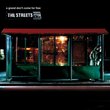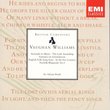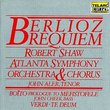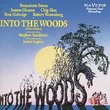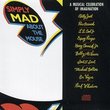| All Artists: National Symphony of Ukraine, Leone Buyse, Richard Toensing, Theodore Kuchar, John Kinzie, Scott Higgins Carol Ou Title: Richard Toensing: Concerto No. 1 for Flute and wind ensemble; Concerto No. 2 for Flute and Orchestra; Fantasia for cello and percussion "Of Angels and Shepherds" Members Wishing: 0 Total Copies: 0 Label: Composers Recordings Original Release Date: 10/1/2001 Release Date: 10/1/2001 Album Type: Import Genre: Classical Styles: Chamber Music, Forms & Genres, Concertos, Historical Periods, Classical (c.1770-1830) Number of Discs: 1 SwapaCD Credits: 1 UPC: 090438088336 |
Search - National Symphony of Ukraine, Leone Buyse, Richard Toensing :: Richard Toensing: Concerto No. 1 for Flute and wind ensemble; Concerto No. 2 for Flute and Orchestra; Fantasia for cello and percussion "Of Angels and Shepherds"
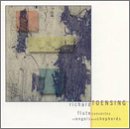 | National Symphony of Ukraine, Leone Buyse, Richard Toensing Richard Toensing: Concerto No. 1 for Flute and wind ensemble; Concerto No. 2 for Flute and Orchestra; Fantasia for cello and percussion "Of Angels and Shepherds" Genre: Classical
Raised in the Lutheran faith, Richard Toensing converted to the Eastern Orthodox Church four years ago, a decision that was ?the end of a long journey? begun when he was a teenager. Initially drawn to the Eastern arm of Ch... more » |
Larger Image |
CD Details
Synopsis
Album Description
Raised in the Lutheran faith, Richard Toensing converted to the Eastern Orthodox Church four years ago, a decision that was ?the end of a long journey? begun when he was a teenager. Initially drawn to the Eastern arm of Christianity through its holy art?the gold-leafed icons of Byzantium?Toensing soon became fascinated with Orthodoxy?s rich traditions, centuries-long continuity and, ultimately, its teachings. ?One thing led to another and I began to say ?I understand this,?? he says of his faith?s natural progression. While not a ?religious composer,? Toensing says it is religious philosophy and theology that ?get the juices flowing.? Both Eastern and Western Christian religious traditions inform Toensing?s works, whether as model for a piece?s form or as an inspirational starting point. Toensing?s most ambitious work thus far is his Responsoria, three books of chanted Roman Catholic prayer services for Holy Week. These responsorial texts have been set by several composers, most notably the 16th-century madrigal writer Gesualdo, who gave Toensing the inspiration to compose his own respon-soria. (Written in 1995 before Toensing?s conversion to the Eastern Church, the Responsoria is perhaps the composer?s own symbolic bridge over the thousand-year schism between Latin and Byzantine churches.) In all of Toensing?s works large and small, however, a listener is most struck by a transparency of sound. By placing but a single idea in each register, Toensing achieves that which many composers have attempted but few (Berio, Bach, Machault come to mind) have accomplished: a sparkling clarity of parts. Toensing begins his compositional process with a chord sequence or group of harmonies, which he frequently uses in strict order ?very much like the old chaconne idea of the Baroque period.? The result is both modern sounding and melodic. ?My music has gotten more diatonic as I?ve gotten older,? confesses Toensing. (Compare the first flute concerto on this disc, written in 1983, and the second one, written 11 years later.) ?I?ve been through the atonal revolution. When I started my graduate work in Michigan, everybody was doing 12-tone work and when I graduated, no one was.? He cites the Polish texture music composer Krzysztof Penderecki?an akin soul who also found inspiration in religious rituals including those of Orthodox Christianity?as one who helped turned the tide in the 1960s away from rigorous atonality and towards blocks of sonorities. With the end of the ?60s came the end of, as Toensing deftly puts it, ?really complicated intellectual music that didn?t seem to be speaking to very many people.? Toensing cites the influential modality of yet another spiritually inspired composer, Arvo Pärt. ?His work gave us permission to write simple gestures?very clear, straightforward music,? says Toensing. Such simplicity is an important part of the aesthetic that informs much of Toensing?s music. Slowly moving harmonic rhythm is another part. A piece of music that races through in the harmonic fast lane poses an aural problem to a man like Toensing. ?There?s all these notes, but which one of them means something?? he asks. A flutist throughout high school and college, Toensing readily admits to a predilection for flute and has written two flute concerti, both heard here for the first time on disc. ?Of all the instruments there are, it?s the one I probably know the best,? he says. ?And I?m sure that if somebody asked me for another flute concerto, I would do it.? (Toensing also professes great affinity for percussion, perhaps stemming from a stint as bass drummer in high school marching band as relief from the ?unrewarding? task of marching as a flute player.) Both concertos here were recorded with the National Symphony of the Ukraine, a happy occurrence for the recently converted Russian Orthodox composer. Theodore Kuchar, Toensing?s colleague from the University of Colorado and a man ?passionately in love with 20th-centur
Similarly Requested CDs
| Boston Pops, Keith Lockhart American Visions Genres: Pop, Soundtracks, Classical Label: RCA | |
| Jane Monheit, Michael Buble Taking a Chance on Love Genres: Jazz, Pop, Broadway & Vocalists Label: Sony | |
| Doobie Brothers Best of the Doobies (Rpkg) Genres: Pop, R&B, Rock, Classic Rock Label: Rhino / Wea | |

 Track Listings (5) - Disc #1
Track Listings (5) - Disc #1
